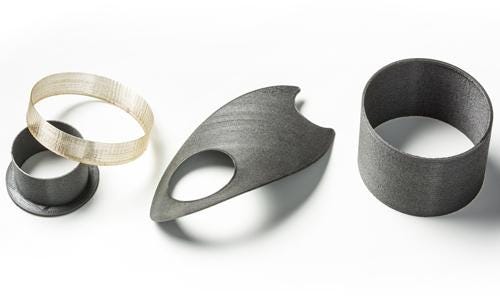3D Printing High-Strength Carbon Composites Using PEEK, PAEK
April 14, 2014

There's been a flurry of news recently about 3D printing carbon composites, both inside and outside the rarefied atmosphere of aerospace. We told you about the MarkOne, the first commercial carbon fiber 3D printer using continuous fiber. Then we reported on an Italian service for making more industrial-strength products and prototypes with 3D-printed carbon fiber composites.
Now there's a new kid on the block. Silicon Valley's Arevo Labs has come out of stealth mode to unveil technology for making high-strength 3D-printed carbon composite end products using matrix materials like ULTEM, as well as Solvay's KetaSpire PEEK, AvaSpire PAEK, PrimoSpire self-reinforced polyphenylene, and Radel polyphenylsulfone (PPSU) resins. The 3D printing startup's technology is not a printer. It's materials and software that can be used with several commercially available fused filament 3D printers in the process of being modified. The technology is aimed at aerospace, defense, and medical OEMs.

3D printing with PEEK and other advanced reinforced polymers has been technically challenging. The MarkOne, for example, uses carbon fiber with a nylon matrix, a more low-end polymer than PEEK-grade resins. The technology is not compatible with current filament fusion systems and requires its own custom printer.
Generally speaking, though, making carbon fiber composite parts with 3D printing has several advantages over traditional methods. "For one thing, you can control the carbon fiber's orientation more precisely than making shapes with traditional methods such as injection molding or extrusion," Hemant Bheda, Arevo Labs' founder and CEO, told us. Since parts are made one layer at a time, each layer can be constructed with any fiber orientation required.
"We believe there are enough people already making printers, and doing that takes a lot of technology," Bheda said. "When we looked at the challenges of doing carbon composite 3D printing, we thought the most difficult and ignored problem to solve was the materials, and we saw there wasn't enough activity there. We understand why: The market has been focused primarily on prototypes, not on end products."
Bheda says Arevo Labs' team has optimized matrix polymer formulations reinforced with carbon fiber and carbon nanotubes, along with inventing some extrusion technology to make the polymers suitable for additive manufacturing. The reinforced materials are tailored to have excellent resistance to high temperatures and chemicals. For example, three grades of Solvay's KetaSpire PEEK have just been qualified by Airbus for use in aircraft interiors. One is carbon fiber filled, and another is glass fiber filled. Airbus previously qualified Solvay's Radel R-7000 PPSU, a material specifically formulated for aircraft interiors.
The other thing Arevo Labs has done is develop specialized software algorithms for its 3D model design and analysis software. The software lets design engineers optimize 3D-printed carbon composite parts for specific mechanical, electrical, and thermal properties -- including deterministic fiber orientation -- resulting in lighter, stronger, and more durable components.
When we interviewed Bheda, he said the team is working with some printer hardware companies to print production parts using the company's materials and software. He wanted to let us know which printer companies these are, but couldn't get their approval until their hardware is ready to sell. I wasn't surprised. That part of the announcement is still flying under the radar. Just 12-18 months ago, I could have made a pretty good guess. But there has been an explosion in 3D printers using filament technology since the patents expired on the original version, Fused Deposition Modeling, commercialized by Stratasys.
Bheda did tell us that his company's technology will work with any commercial filament fusion printer that can print high-performance materials, as long as it can achieve the required high temperatures. Arevo Labs' new extrusion technology is a printer head design and firmware that have been optimized for use with reinforced materials. These and other materials have been fully tested with an off-the-shelf desktop printer that the team modified. They put a high-temperature printer head on it, modified the software, and used that to print test parts on site.
Related posts:
About the Author(s)
You May Also Like



